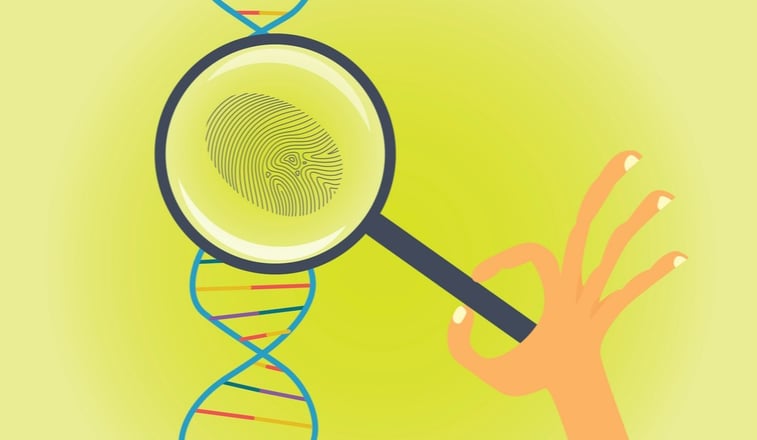Share this
using genetic profiling to verify identity of remote samples
by James Rudge, PhD, Technical Director, Trajan on Jul 18, 2022 9:00:00 AM
A poster produced in 2021 by Emma Fischer et al at Promega Corporation, reported on a novel procedure to reliably conduct genetic profiling of blood microsamples collected using Mitra® devices based on VAMS® technology. The poster is entitled “Extraction to Electrophoresis – Verifying Identity of Remotely Collected Blood Samples.” It describes the steps to follow from sample extraction to omics data gathering to generating a molecular fingerprint of an individual’s identity from a microsample of their blood.
The authors concluded that this approach is a useful tool for secure sample identity. In their poster, the authors have provided a workflow that includes DNA extraction, DNA quantification, STR amplification, and capillary electrophoresis. They state that their methods can be used to confirm the identity of blood samples collected remotely on Mitra® microsampling devices.
The Advent of Genetic Profiling
In 1984, Sir Alec Jeffreys, a pioneer in genetics at the University of Leicester, United Kingdom, invented the genetic profiling technique known as “genetic fingerprinting.” Genetic profiling was first used in 1988 to exonerate suspect Richard Buckland and convict Colin Pitchfork for the murder of two teenagers in Leicestershire, UK.
This technique is now a key tool used in the forensic investigation of crimes as well as many other fields, such as paternity testing. The technique is also an important tool used in cancer diagnosis and in cellular biology to qualify control germ cell lines.
How does genetic profiling work?
Although there is 99.9% homology in human DNA, within the remaining 0.1%, there are distinct differences between individuals, which make up the specific characteristics of each person. The only exception to this is when we are comparing DNA from identical twins where DNA between them is almost identical. DNA fingerprinting examines specific highly variable regions of the DNA, called variable number tandem repeats (or VNTRs), which differ from one individual to another.
VNTRs are base sequences on DNA which repeats contiguously. Although individuals will have the same repeated base sequences, the number of sequences differs, and it is this difference in the number of repeats that genetic profiling exploits (see Figure 1). A variant of VNTRs are called short tandem repeats which, as the name implies, are VNTRS with shorter base sequences.
 Figure 1. A difference in the number of short tandem repeats (a type of VTNR) between individual subjects.
Figure 1. A difference in the number of short tandem repeats (a type of VTNR) between individual subjects.
There are several steps in the processing of samples for genetic profiling, the first of which is to extract intact DNA from the sample. There are a variety of ways to do this, including organic extraction and SPE. Next, the sample is quantitatively measured for the amount of DNA it contains. After this, the sample is amplified using the polymerase chain reaction (PCR), where primers specific to known VNTRs (or to known short tandem repeats {STRs}) are employed and amplified using thermocycling. Finally, the amplicons are separated by electrophoresis. This gives the classic ‘barcode’ pattern on an electrophoretic gel where each bar is a specific tandem repeat number for a specific location on the DNA.
Genetic Profiling of Microsamples for Sample Identification
Since the COVID-19 Pandemic, there has been a noticeable shift in clinical trial design from traditional onsite or in-clinic trials to remote or decentralized clinical trials. We have also seen a transition to a mix of both, called a “hybrid trial” design. There are a number of benefits to this transition away from onsite trials. The first benefit is reducing the burden of travel for patients whereby they don’t have the inconvenience of making frequent trips to the clinic for trial-related appointments. A second major benefit is the significant reduction in costs that remote trials offer. It has been reported that clinical trials cost a median of $41,117 per patient and $3,562 per patient visit to the trial site.
To help defray these trial costs, many organizations in recent years have conducted decentralized clinical trials by offering their trial volunteers dried matrix remote sampling options using at-home tools such as the Mitra device and HemaPEN. For example, at the outset of the COVID-19 Pandemic, a remote clinical trial was conducted using Mitra devices to collect capillary blood samples from healthcare workers to see if Hydroxychloroquine offered any prophylactic protection against SARS-CoV-2. While the results of this study indicated that hydroxychloroquine did not offer protection against the virus, it demonstrated the utility of remote sampling during pandemic lockdowns and restrictions.
One concern expressed regarding remote sampling is ensuring sample integrity and identity. Sample integrity can be solved by conducting appropriate robustness testing during analytical validations. Studies have shown that many analytes remain stable in dried samples at extremes of temperature during transport. Sample identity is another concern to those designing remote trials, because they want to be sure a sample has been collected by the correct individual.
One option to solve this is to have samples collected in the presence of another person such as a healthcare worker – either virtually via an on-camera video call or in person via a mobile unit that visits the subject’s home. Another solution is to genetically profile the sample prior to analysis of the analyte of interest. This approach may be more convenient, and an added benefit is that the samples could be sent with no affixed labels for patient identification as the ID process would be conducted genetically in the lab.
Identifying Remotely Collected Blood Samples with Genetic Profiling
Recently, Promega Corporation successfully developed a protocol for the extraction of DNA from dried blood samples using Mitra devices for the intended purpose of verifying the identity of remotely collected blood samples. Their protocol is summarized below and is detailed in their poster.
- Mitra devices with VAMS tips (30 µL) were extracted in a buffer containing proteinase K to remove the protein and release the cellular DNA. The sample extracts were then purified using a Maxwell® RSC Instrument.
- Following purification, samples were quantified using either a fluorescent dye-based method (QuantiFluor® ONE dsDNA System on a Quantus™ Fluorometer) or an amplification-based method (ProNex® DNA QC Assay).
- The samples were then PCR amplified using the GenePrint® 24 System, which is designed to generate a multi-locus human DNA profile from a variety of human-derived biological samples. Polymorphic STR loci (n=22) and two loci for sex determination were utilized. The amplicons were then separated by capillary electrophoresis on the Spectrum Compact CE System.
- Finally, data analysis was conducted by employing GeneMapper™ IDX v1.6 software.
- The data was paired to a standard buccal swab reference protocol.
Promega Study Results and Conclusions
The identity of blood samples collected remotely on Neoteryx Mitra microsampling devices may be verified through the provided workflow through DNA extraction, DNA quantification, STR amplification, and capillary electrophoresis.- Consistent high-quality DNA concentrations were observed across three duplicate Mitra® microsamples.
- Concordant loci and allele calls were observed using the GenePrint® 24 System for each paired reference buccal swab and Mitra® blood microsample.
Neoteryx Conclusions
The work conducted by Promega showed that high-quality DNA samples were successfully extracted and analyzed for the confirmation and identity of blood samples. In terms of stability, we know from previous work on EPO transgene detection from Mitra extracts that Alexandre Marchand et al, had demonstrated good stability on the microsamples for at least one month when stored at room temperature.
One concern expressed with regard to genetic profiling of blood samples is that the data generated from the genetic test could potentially be used inappropriately. For example, the data might be used to reveal the sample donors’ risks of developing specific diseases.
However, the assay developed by Promega acts only as a sample identifier by identifying the gender of the individual and genetically “barcoding” the sample for that specific person. It does not probe for other information, such as any health risks, so the data could not be misappropriated for other purposes. Therefore, this work shows promise as a safe avenue for molecular sample identification that could act as a tool for anonymous sample identity for utility in remote or decentralized clinical trials.
This poster was summarized for our readers by James Rudge, PhD, Neoteryx Technical Director. This is curated content. To learn more about the important research outlined in this blog, visit the original poster from Promega.
To learn more about the application of blood microsampling for Omics research visit this page.
Image Credits: iStock, Promega, Neoteryx
Share this
- Microsampling (206)
- Research, Remote Research (119)
- Venipuncture Alternative (105)
- Clinical Trials, Clinical Research (83)
- Mitra® Device (73)
- Therapeutic Drug Monitoring, TDM (51)
- Dried Blood Spot, DBS (39)
- Biomonitoring, Health, Wellness (30)
- Infectious Disease, Vaccines, COVID-19 (24)
- Blood Microsampling, Serology (23)
- Omics, Multi-Omics (21)
- Decentralized Clinical Trial (DCT) (20)
- Specimen Collection (18)
- Toxicology, Doping, Drug/Alcohol Monitoring, PEth (17)
- Skin Microsampling, Microbiopsy (14)
- hemaPEN® Device (13)
- Preclinical Research, Animal Studies (12)
- Pharmaceuticals, Drug Development (9)
- Harpera Device (7)
- Industry News, Microsampling News (5)
- Antibodies, MAbs (3)
- Company Press Release, Product Press Release (3)
- Environmental Toxins, Exposures (1)
- July 2025 (1)
- May 2025 (1)
- April 2025 (2)
- December 2024 (2)
- November 2024 (1)
- October 2024 (3)
- September 2024 (1)
- June 2024 (1)
- May 2024 (1)
- April 2024 (4)
- March 2024 (1)
- February 2024 (2)
- January 2024 (4)
- December 2023 (3)
- November 2023 (3)
- October 2023 (3)
- September 2023 (3)
- July 2023 (3)
- June 2023 (2)
- April 2023 (2)
- March 2023 (2)
- February 2023 (2)
- January 2023 (3)
- December 2022 (2)
- November 2022 (3)
- October 2022 (4)
- September 2022 (3)
- August 2022 (5)
- July 2022 (2)
- June 2022 (2)
- May 2022 (4)
- April 2022 (3)
- March 2022 (3)
- February 2022 (4)
- January 2022 (5)
- December 2021 (3)
- November 2021 (5)
- October 2021 (3)
- September 2021 (3)
- August 2021 (4)
- July 2021 (4)
- June 2021 (4)
- May 2021 (4)
- April 2021 (3)
- March 2021 (5)
- February 2021 (4)
- January 2021 (4)
- December 2020 (3)
- November 2020 (5)
- October 2020 (4)
- September 2020 (3)
- August 2020 (3)
- July 2020 (6)
- June 2020 (4)
- May 2020 (4)
- April 2020 (3)
- March 2020 (6)
- February 2020 (3)
- January 2020 (4)
- December 2019 (5)
- November 2019 (4)
- October 2019 (2)
- September 2019 (4)
- August 2019 (4)
- July 2019 (3)
- June 2019 (7)
- May 2019 (6)
- April 2019 (5)
- March 2019 (6)
- February 2019 (5)
- January 2019 (8)
- December 2018 (3)
- November 2018 (4)
- October 2018 (7)
- September 2018 (6)
- August 2018 (5)
- July 2018 (8)
- June 2018 (6)
- May 2018 (5)
- April 2018 (6)
- March 2018 (4)
- February 2018 (6)
- January 2018 (4)
- December 2017 (2)
- November 2017 (3)
- October 2017 (2)
- September 2017 (4)
- August 2017 (2)
- July 2017 (4)
- June 2017 (5)
- May 2017 (6)
- April 2017 (6)
- March 2017 (5)
- February 2017 (4)
- January 2017 (1)
- July 2016 (3)
- May 2016 (1)
- April 2016 (2)



No Comments Yet
Let us know what you think